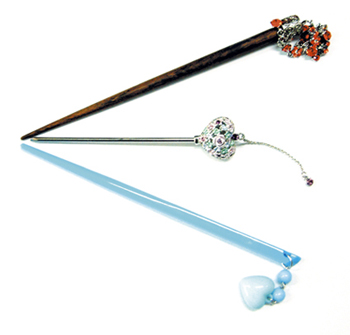"NOT BEING able to follow you in your long journey,
I took my Binyeo out of my hair
And left it for you to include it with your supplies".
(Poem from the Joseon Dynasty)
Seeing her loved one leaving, a woman parts with her "Binyeo", which seems to be a common object. Why then does she choose binyeo -from all her belongings- to give it to her love? What precious meaning does it hold? 
Used when doing one's long hair in a chignon, Binyeo is a traditional ornamental hairpin found in Korea, best known in its shape of a long stick. It can also be found in China and Japan. While Japanese Binyeo is different in that it is made of two sticks, Chinese and Korean ones are quite similar. However, they both have been adapted differently according to each country's common hairstyle.
According to historical records, Binyeo has been used in Korea since the Three Kingdom Dynasty. At that time most Binyeos assumed a "U" form and were called Chae. As a popular hairstyle was to make one's hair abundant by fixing a part-wig, the "U" form was more practical. The stick-shaped Binyeo, or Jam, became widespread only during the Joseon Dynasty, under King Youngjo's rule (18th century). During this period, the abundant style, considered too extravagant, was banned and the chignon became the standard hairstyle. The long Binyeo was then used to maintain one's hair in a tight bun. The only useful ornament left, it soon flourished in style.
The types of Binyeos differ according to the material used, but also the shape of their ends. The body part of the hairpin is usually a simple stick, but the head part, called Jamdu, can be very diverse. The name given to a particular Binyeo is sometimes enough to guess its substance and its form. For example, Gumbongjam is a jam made of gold (gum) with phoenix (bong) patterns.
The pattern and material of Binyeos were a way to distinguish social classes. Royal women wore Binyeos made of gold or silver with dragon pattern at the Jamdu, while those in the upper class had pearl or jade Binyeos. Most common people simply used Binyeos made of wood or horn.
Binyeo also held another special meaning to Korean women. Doing one's hair in a chignon with a Binyeo for the first time was an important coming-of-age ceremony for young girls. It meant that the young girl was now a woman, thus ready to be wed. Offering a Binyeo to a woman was asking her for marriage. Breaking it meant betrothal. Dreaming of losing it was bad luck and finding one meant fortune. A tradition was also born from it. At the Dano festival, it was custom for women to wash their hair in water with lily extract, and wear a Binyeo made of lily roots. It was a wish for a long life of happiness. 
▲ From past to present: hairstyle with binyeo
Binyeo can still be found today and has also been introduced in the western world. Since then, it has been a symbol of the Orient and a fashionable hairpin. Following the flow of time, it is made with modern materials such as plastics, wood and imitation diamonds, and it is especially popular in hot summer. Modified according to time, Binyeo has taken a place in today's fashion. The traditional binyeos left now still show the culture of past times and handmade art, so the meaning has not faded away. The fact that binyeo of today has been able to establish itself as a new trend, a new culture different from the socio-cultural facet it had, can in fact, be seen as a successful transition," explains Cho Hee-jin, from The National Folk Museum of Korea.
Binyeo, on its own, embodied feminism, maturity, purity and grace. Although it is no longer made of the traditional materials, and has evolved with more modern decoration, it can still hold a special meaning to women. It is now summer. Now could be a good opportunity to wear the traditional hairpin: be fashionable while remembering the noble and graceful posture of Joseon women.
Fun Facts 1. Men also used Binyeo to tie a topknot or to fix official hats! It was however not as sumptuous as for women. 2. Against food poisoning! Silver binyeos were often used to check on food freshness and presence of poisonous substances. 3. Emergency funds! Some binyeos were made of quite precious materials. They could be sold at high prices. Just in case.

